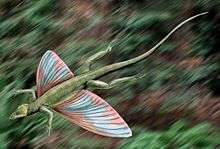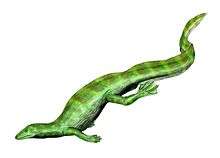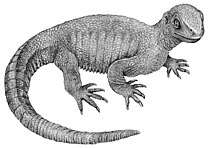Coelurosauravus
Coelurosauravus (meaning "hollow lizard grandfather") is a genus of basal diapsid reptiles. Like its relatives in the family Weigeltisauridae, members of this genus possessed long, rod-like ossifications along the edge of the body. These bony rods were not extensions of the ribs but were instead newly developed bones derived from the skin of the animal, a feature which is unique to the genus and its close relatives. It is believed that during life, these structures were covered with skin, forming wing-like surfaces which Coelurosauravus could use for gliding.[1]
- For the group of theropod dinosaurs, see Coelurosauria.
| Coelurosauravus | |
|---|---|
 | |
| Life restoration of Coelurosauravus (Weigeltisaurus) jaekeli | |
| Scientific classification | |
| Kingdom: | Animalia |
| Phylum: | Chordata |
| Class: | Reptilia |
| Family: | †Weigeltisauridae |
| Genus: | †Coelurosauravus Piveteau 1926 |
| Type species | |
| †Coelurosauravus elivensis Piveteau, 1926 | |
| Species | |
| |
| Synonyms | |
|
C. elivensis
C. jaekeli
| |
Coelurosauravus was originally known from a single species, C. elivensis, which was named in 1926 based on fossils from the Sakamena Formation of Madagascar. Many other genera of weigeltisaurids have been lumped into Coelurosauravus since its original discovery. Most notable of these was Weigeltisaurus jaekeli, originally described from Germany in 1930. This European species is now known from numerous specimens found in Germany (and one in England), of which some were very well preserved. In 1987, Weigeltisaurus jaekeli was synonymized with Coelurosauravus as a second species, Coelurosauravus jaekeli.[1] However, a 2015 study reinstated Weigeltisaurus as a separate genus for "Coelurosauravus" jaekeli.[2]
Coelurosauravus specimens had an average length of 40 centimetres (16 in). The body was long and flat, suitable for gliding. The skull was lizard-like with a pointed snout and contained a broad back with a serrated crest, superficially resembling the crests of ceratopsian dinosaurs.[3]
Specimens
Daedalosaurus madagascariensis Carroll, 1978, based on a specimen from the Late Permian Sakamena Formation of the Morondava Basin in Madagascar, is a synonym of Coelurosauravus elivensis, the type species of Coelurosauravus.[4] Gracilisaurus ottoi and Weigeltisaurus jaekeli, both from the Late Permian Kupferschiefer of northeastern Germany, were also synonymized with Coelurosauravus in 1987. Weigeltisaurus jaekeli was retained as a separate species of Coelurosauravus, Coelurosauravus jaekeli.[1] However, a pair of 2015 studies by Bulanov & Sennikov re-evaluated skull material referred to Coelurosauravus[5] and reinstated Weigeltisaurus jaekeli as a valid genus.[2]
Coelurosauravus elivensis
Known from the Sakamena formation of Madagascar.
- IP 1908-11-21a: Holotype of C. elivensis (Piveteau, 1926). A poorly preserved skull and partial skeleton.
- IP 1908-11-22a: A part and counterpart (IP 1908-11-23a) containing skull fragments and the anterior half of a skeleton.
- IP 1908-5-2: Holotype of Daedalosaurus madagascariensis (Carroll, 1978). A part and counterpart (IP 1908-5-2b) of a partial skeleton including skull pieces and gliding structures.
Coelurosauravus (Weigeltisaurus) jaekeli
Known from the Kupferschiefer of Germany and the Marl Slate of England.
- Greifswald specimen (SSWG 113/7): Holotype of Palaeochamaleo/Weigeltisaurus/Coelurosauravus jaekeli (Weigelt, 1930). A partial skeleton including a well-preserved skull, vertebrae, limbs, and gliding structures.
- GM 1462: Holotype of Gracilisaurus ottoi (Weigelt, 1930). A partial skeleton including a forelimb, neck vertebrae, skull fragments, and gliding structures.
- Wolfsberg & Cornberg specimens: Privately owned specimens described by Schaumberg (1976).
- Eppleton specimen (TWCMS B.5937 1&2): A well-preserved partial skeleton including the torso, hindlimbs, part of the tail, and gliding structures all in articulation. The only Coelurosauravus specimen known from England, specifically the Marl Slate near Hetton-le-Hole, Tyne and Wear. First described in Nature by Pettigrew (1979).[6]
- Bodental specimen: A privately owned specimen described by Schaumberg (1986).
- Ellrich specimen (SMNK 2882 PAL): A well-preserved and fully articulated complete skeleton first described in Science magazine by Frey, Sues, & Munk (1997).[7][8]
See also
References
- Evans, Susan E.; Haubold, Hartmut (1 July 1987). "A review of the Upper Permian genera Coelurosauravus, Weigeltisaurus and Gracilisaurus (Reptilia: Diapsida)". Zoological Journal of the Linnean Society. 90 (3): 275–303. doi:10.1111/j.1096-3642.1987.tb01356.x. ISSN 0024-4082.
- Bulanov, V.V.; Sennikov, A.G. (2015). "Substantiation of Validity of the Late Permian Genus Weigeltisaurus Kuhn, 1939 (Reptilia, Weigeltisauridae)". Paleontological Journal. 49 (10): 1101–1111. doi:10.1134/S0031030115110039.
- Palmer, D., ed. (1999). The Marshall Illustrated Encyclopedia of Dinosaurs and Prehistoric Animals. London: Marshall Editions. p. 83. ISBN 978-1-84028-152-1.
- Evans, S. E. (October 1982). "The gliding reptiles of the Upper Permian". Zoological Journal of the Linnean Society. 76 (2): 97–123. doi:10.1111/j.1096-3642.1982.tb01496.x. ISSN 1096-3642.
- Bulanov, V. V.; Sennikov, A. G. (July 2015). "New data on the morphology of the Late Permian gliding reptile Coelurosauravus elivensis Piveteau". Paleontological Journal. 49 (4): 413–423. doi:10.1134/S0031030115040048. ISSN 1555-6174.
- Pettigrew, T. H. (27 September 1979). "A gliding reptile from the Upper Permian of North East England". Nature. 281 (5729): 297–298. doi:10.1038/281297a0. ISSN 1476-4687.
- Frey, Eberhard; Sues, Hans-Dieter; Munk, Wolfgang (7 March 1997). "Gliding Mechanism in the Late Permian Reptile Coelurosauravus". Science. 275 (5305): 1450–1452. doi:10.1126/science.275.5305.1450. ISSN 1095-9203.
- Schaumberg, Günther; Unwin, David M.; Brandt, Silvio (30 June 2007). "New information on the anatomy of the Late Permian gliding reptileCoelurosauravus". Paläontologische Zeitschrift. 81 (2): 160–173. doi:10.1007/BF02988390.
Further reading
- Parker, Steve. Dinosaurus: the complete guide to dinosaurs. Firefly Books Inc, 2003. Pg. 98
- Lambert D, Naish D, and Wyse E (2001) Encyclopedia of Dinosaurs and Prehistoric Life, p. 77, Dorling Kindersley Limited, London. ISBN 0-7513-0955-9




